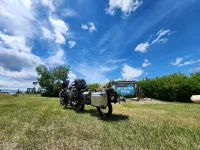On our shortcut to Montana. ( see "Let them eat cake") The load goes as follows. The bike left pannier dress shoes for wedding and sneakers.bag on top my sleeping bag. Right pannier wife's bed roll.
Trailer left front my clothes right front her clothes.
Hard box cake making supplies
Cooler a couple bottles of pop no ice.
Sag set to specs. Awesome ride a bit more weight on front of trailer. Riding in auto road height on the bike.1750 miles just fine.
Stop at wally world and grab the cake making stuff. We added about 40lbs to the rear of the trailer. I was worried as I try to keep more weight forward. I had to add a little more air to the trailer suspension to adjust sag. We balanced the weight in the cooler and metal pannier. The headed the last 60 miles with the
A couple twisty spots and 75mph on the interstate. Pulled the same as it had the entire trip.
We are staying 30 miles from the wedding venue. I have removed all the soft luggage. So the weight of the cake stuff will all be on the rear. I will readjust the sag and head the 30 miles and see how it effects the ride.
Trailer left front my clothes right front her clothes.
Hard box cake making supplies
Cooler a couple bottles of pop no ice.
Sag set to specs. Awesome ride a bit more weight on front of trailer. Riding in auto road height on the bike.1750 miles just fine.
Stop at wally world and grab the cake making stuff. We added about 40lbs to the rear of the trailer. I was worried as I try to keep more weight forward. I had to add a little more air to the trailer suspension to adjust sag. We balanced the weight in the cooler and metal pannier. The headed the last 60 miles with the
A couple twisty spots and 75mph on the interstate. Pulled the same as it had the entire trip.
We are staying 30 miles from the wedding venue. I have removed all the soft luggage. So the weight of the cake stuff will all be on the rear. I will readjust the sag and head the 30 miles and see how it effects the ride.

